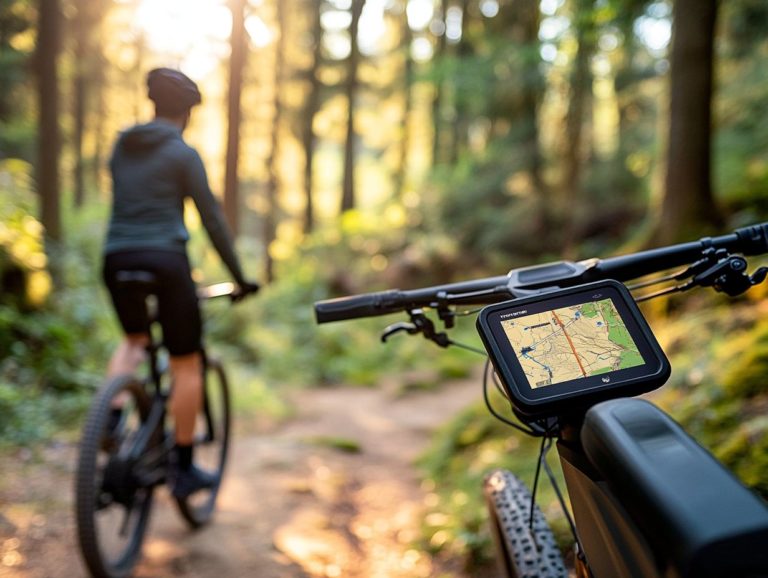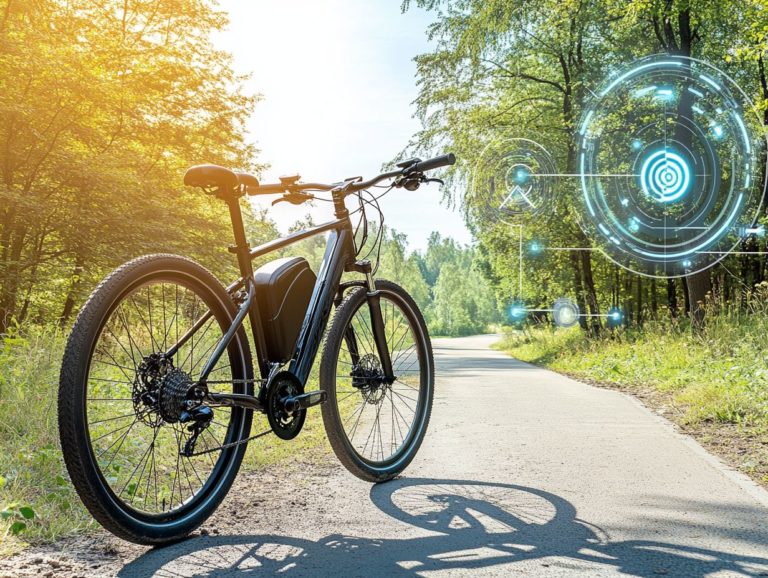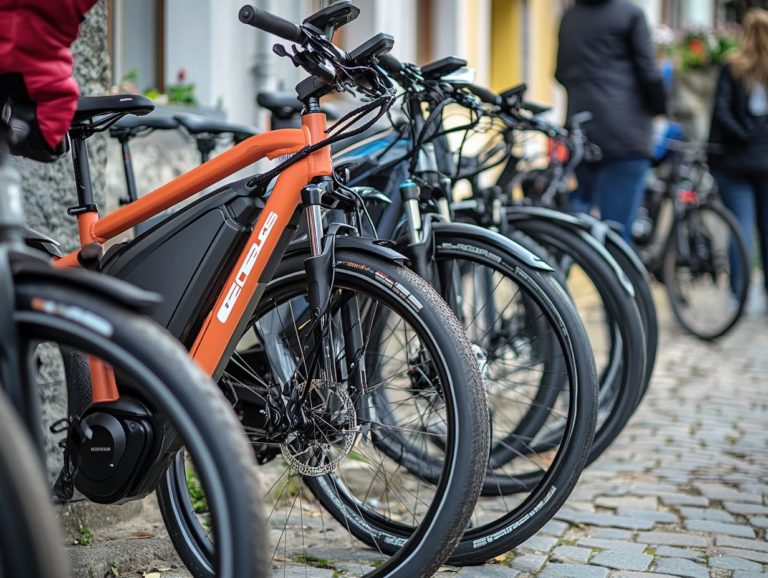What is Pedal Assist on an Electric Bicycle?
Pedal assist is revolutionizing your cycling experience, particularly with electric bicycles. This feature empowers you by providing an extra boost while you pedal, making longer distances and challenging terrains much more attainable.
You ll delve into how pedal assist functions, its essential components, and the different types available. Discover the myriad benefits it brings, from enhancing your riding pleasure to promoting both health and environmental sustainability.
You will also discover valuable tips for using and maintaining your pedal assist system to keep it performing at its best. Get ready to transform your cycling experience!
Contents
- Key Takeaways:
- How Pedal Assist Works
- Benefits of Pedal Assist
- Types of Pedal Assist Systems
- Tips for Using Pedal Assist
- Common Questions About Pedal Assist
- What is Pedal Assist on an Electric Bicycle?
- How does Pedal Assist work on an Electric Bicycle?
- What are the benefits of using Pedal Assist on an Electric Bicycle?
- Is Pedal Assist legal to use on an Electric Bicycle?
- Do I need to pedal at all when using Pedal Assist on an Electric Bicycle?
- Can I turn off Pedal Assist on my Electric Bicycle?
Key Takeaways:
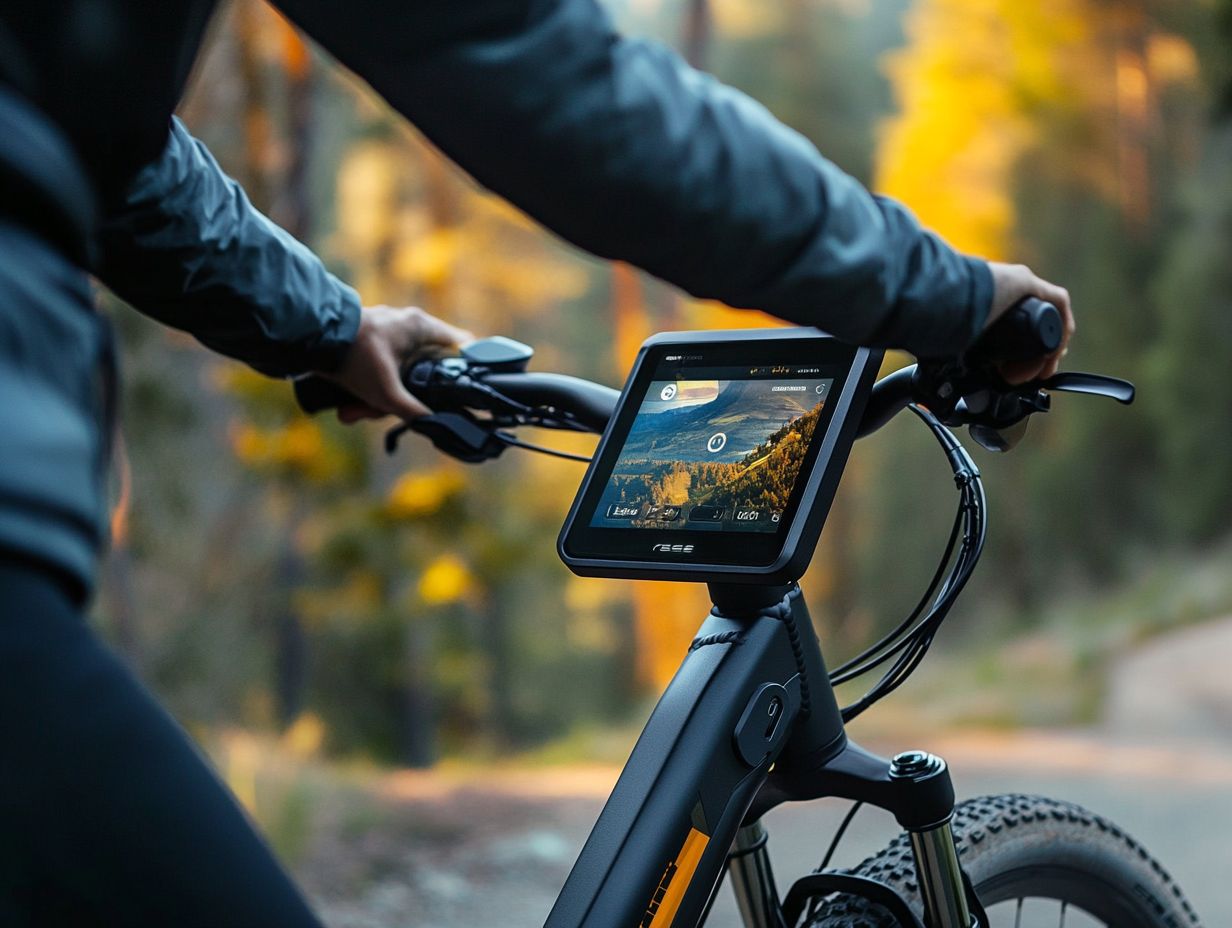
- Pedal assist is a feature on electric bicycles that helps riders by providing a boost of power while pedaling.
- Pedal assist works by using sensors to detect your pedaling and activating a motor to provide additional power.
- Using pedal assist can enhance your riding experience, improve your health, and reduce environmental impact. It’s important to use proper technique and maintain your electric bicycle for optimal performance.
What is Pedal Assist?
Pedal assist technology is designed to elevate your cycling experience by providing that extra boost you need to conquer longer distances and tackle challenging terrains with ease. This innovative system works seamlessly with your own pedal power, making it perfect for urban commuting, hill climbs, and even for those with average fitness levels who want to enjoy longer rides without feeling completely worn out.
With various assist levels at your fingertips, you can customize your ride to fit your fitness and performance needs whether you re after a gentle nudge or a more powerful push. The pedal assist system intelligently analyzes your inputs, optimizing energy efficiency and ensuring that each pedal stroke receives just the right amount of support.
As a result, you ll experience a more gratifying ride, reveling in the thrills of cycling while feeling significantly less fatigued. Enjoy riding more often, boost your fitness, and help the environment. You ll also appreciate the commuting benefits, making daily travel smoother.
How Pedal Assist Works
Grasping the details of a pedal assist system is crucial for elevating your cycling experience. This system harmoniously integrates components such as torque sensors, cadence sensors, and an e-bike motor, ensuring a ride that fluidly adapts to your input. Knowing how the drivetrain works can make your ride even better.
This technology gives you an advantage in urban settings, allowing you to select assist levels that cater to your individual preferences and the demands of varying terrains. Throttle assist options provide that extra boost when starting or stopping, making your journey even more enjoyable, especially when biking uphill.
Components and Mechanisms
The core components of a pedal assist system include torque sensors, cadence sensors, and a robust e-bike motor, each fulfilling a vital function in providing a personalized cycling experience. Understanding how these sensors and the motor interact can significantly improve your ride enjoyment.
These elements work together seamlessly, delivering assistance that s finely tuned to your unique riding style. For example, the torque sensor measures how hard you’re pedaling, ensuring the motor reacts in a natural way, while the cadence sensor adjusts the bike’s power output based on your speed.
Brands like Pedego utilize these technologies to enhance your experience, featuring intuitive displays that present real-time data at a glance. Similarly, Velotric incorporates smart algorithms, enabling their e-bikes to adapt effortlessly to varying terrains, whether you re gliding along a flat road or conquering steep inclines. Other brands like SDREAM also offer innovative designs.
This integrated approach not only enhances energy efficiency but also elevates the sheer joy of cycling, making each ride an experience to remember.
Benefits of Pedal Assist
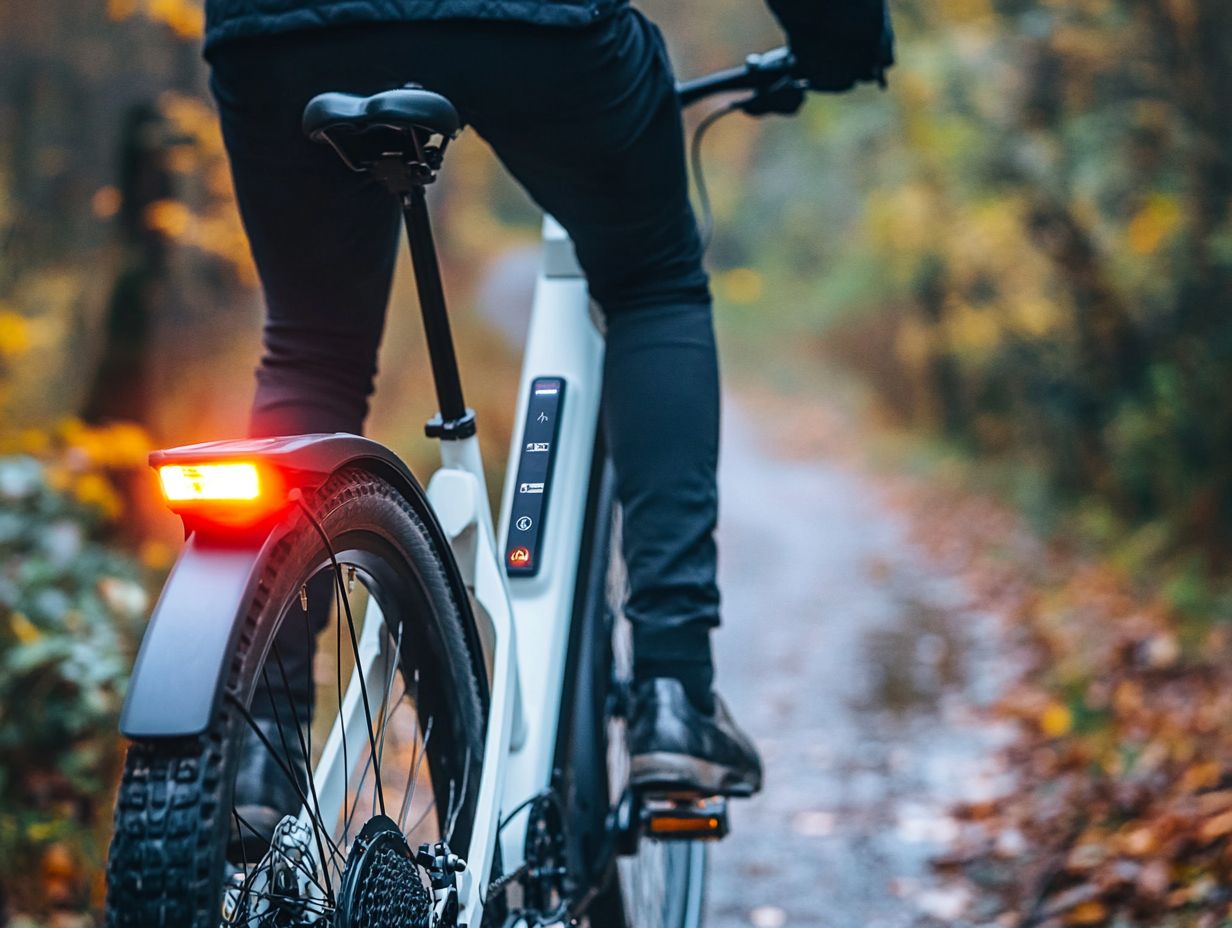
Embracing pedal assist technology offers many advantages that enhance your cycling experience. It makes cycling an enticing option for both newcomers and seasoned riders.
The combination of pedal assist systems and e-bikes caters to riders of all skill levels.
Pedal assist technology provides substantial health and environmental perks, promoting a more sustainable future and encouraging physical fitness through enjoyable rides. This is especially appealing for urban commuters.
Enhanced Riding Experience
The enhanced riding experience brought by pedal assist technology revolutionizes how you cycle. It allows you to pedal with ease, even in challenging terrains or during lengthy urban commutes.
You gain greater control and comfort, making cycling an accessible pastime for individuals of all fitness levels, whether you re bikepacking or on a leisurely ride.
This innovation simplifies tackling steep hills or weaving through busy city streets. It encourages longer rides without the fatigue common in traditional cycling.
As you engage with pedal assist, you can maintain a steady pace effortlessly, turning everyday outings into delightful adventures instead of exhausting treks. This enhances your overall cycling experience.
The sense of enablement from increased endurance boosts your confidence, making bike commuting a more appealing option for urban dwellers seeking eco-friendly transportation.
Ultimately, pedal assist enhances not just your performance but also the overall satisfaction you derive from cycling, turning it into a pleasurable and practical choice for everyone.
Health and Environmental Benefits
The health and environmental benefits of pedal assist systems are remarkable. By promoting regular cycling, you enhance your physical fitness while contributing positively to the planet.
As more commuters choose pedal assist bikes, you ll notice a significant reduction in vehicle emissions. This leads to cleaner urban air and healthier lifestyles, making e-bikes a practical solution.
Cycling boosts your cardiovascular fitness, making your heart stronger and more efficient. It also enhances mental well-being, helping to reduce stress and anxiety levels.
By incorporating cycling into your daily routine, you ll likely experience increased energy levels and an improved mood. This fosters a sense of community among fellow cyclists, further encouraging the use of pedal assist technology.
With fewer cars on the roads, you ll notice a significant decrease in traffic congestion, enhancing mobility in cities. This transformation encourages a more sustainable future where cleaner transportation alternatives become the standard.
Types of Pedal Assist Systems
Pedal assist systems are classified into three categories: Class 1, Class 2, and Class 3. Each class provides varying levels of assistance and functionalities tailored to diverse riding preferences.
By understanding these classifications, you can make informed decisions when selecting the ideal e-bike for your unique riding style, ultimately elevating your overall cycling experience.
Comparison and Features
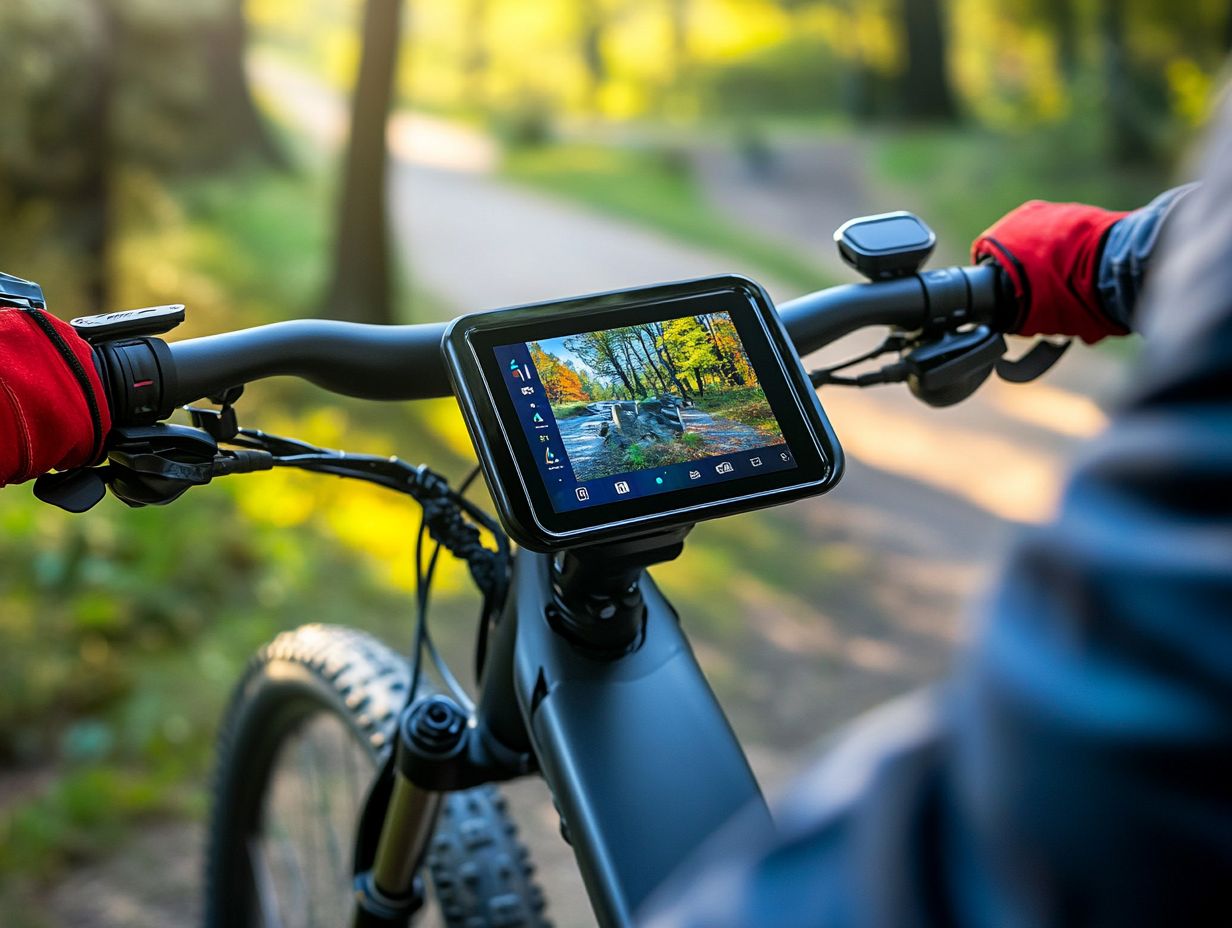
When you compare pedal assist systems, it s crucial to understand the unique features that differentiate Class 1, Class 2, and Class 3 e-bikes. Each class is tailored for distinct riding scenarios and experiences. Class 1 bikes provide assistance only while you’re pedaling. Class 2 models offer throttle assist. Class 3 options allow for higher speeds and greater assistance while still retaining a pedal-only mode.
These distinctions significantly influence user preferences, especially when considering various riding styles and terrains. For instance, if you opt for a Class 1 e-bike, like the Nomad 1, you’ll likely appreciate its natural cycling experience. This makes it a favorite among commuters who desire a workout without excessive assistance.
Class 2 bikes, such as the Discover 1, are perfect for leisurely rides in urban environments. A quick twist of the throttle helps you weave through traffic effortlessly. Meanwhile, Class 3 bikes excel on challenging terrains, enabling riders to conquer hills with ease! They are ideal for adventurous souls seeking a thrill.
Each class not only enhances your riding experience but also aligns with your specific needs, creating a personalized e-biking experience.
Tips for Using Pedal Assist
To truly harness the advantages of pedal assist technology, it’s essential for you to embrace effective techniques and maintenance practices. These will keep your e-bike operating at its best. Understanding energy drainage can also help you maximize your riding experience.
Mastering this knowledge enhances your cycling experience and extends the lifespan of vital components, such as sensors and the e-bike’s motor. This ensures optimal performance in all scenarios.
Proper Technique and Maintenance
Adopting proper techniques and performing regular maintenance on your pedal assist bike are essential responsibilities for any e-bike rider. This ensures a smoother ride and enhances long-lasting performance. Familiarizing yourself with the operation of torque and cadence sensors which measure how hard you pedal and track your pedaling speed, respectively along with periodic checks on the e-bike’s motor, can significantly elevate your riding experience.
By adjusting pedal assist settings to suit varying ride conditions whether you’re tackling steep hills or battling headwinds you can optimize the bike’s power output. This not only makes each journey more enjoyable but also less physically demanding.
Keeping a vigilant eye on crucial components such as the battery, brakes, and drivetrain is vital to ensure everything operates seamlessly. A maintenance checklist should include:
- Cleaning and Lubricating the Chain
- Inspecting Tire Pressure
- Testing Sensor Accuracy
Regular upkeep extends the lifespan of your bike and maximizes your ride enjoyment! Transform each outing into a thrilling adventure!
Common Questions About Pedal Assist
What is Pedal Assist on an Electric Bicycle?
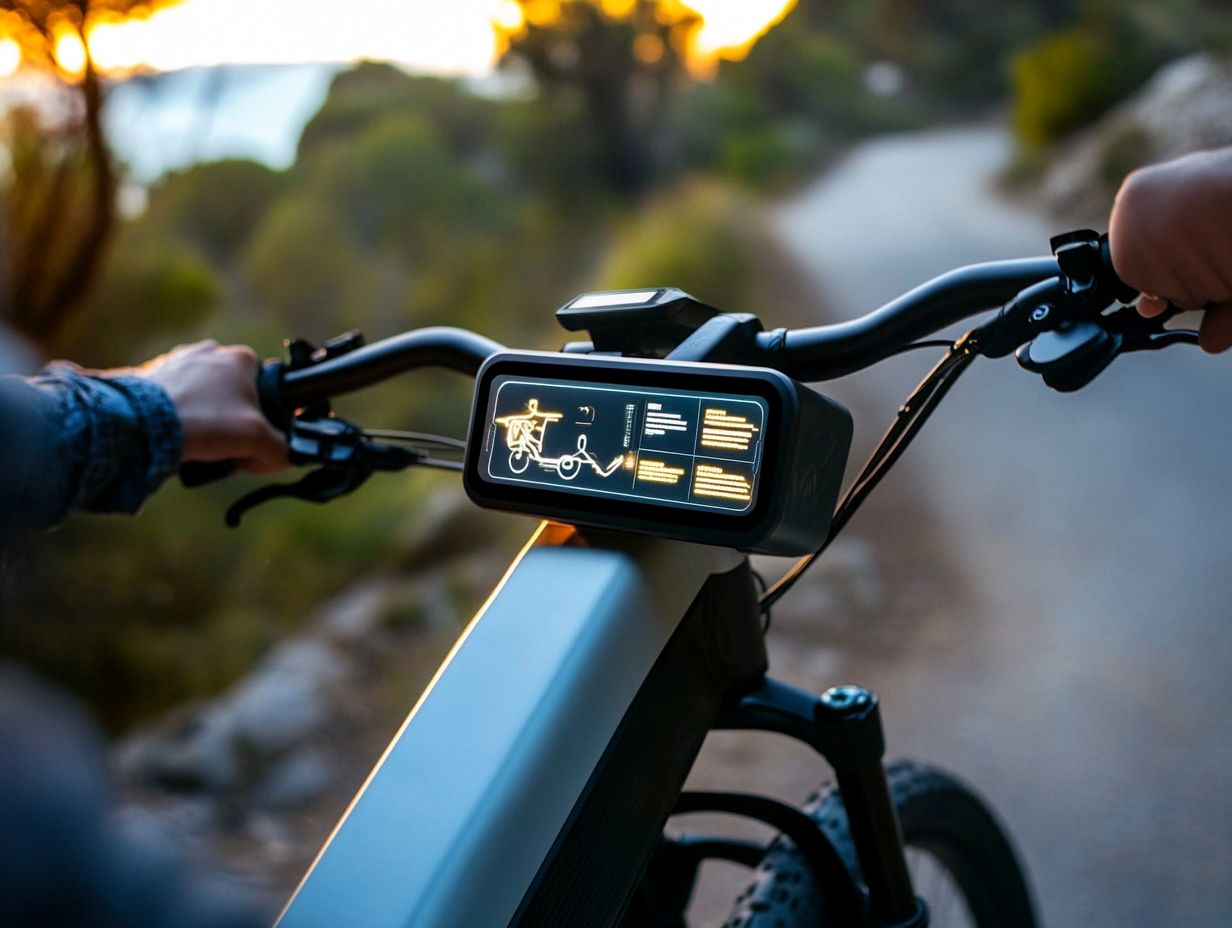
Pedal assist on an electric bicycle is a feature that allows the rider to choose between manually pedaling the bike or using a motor to assist with pedaling.
How does Pedal Assist work on an Electric Bicycle?
Pedal assist works by using sensors that detect the rider’s pedaling motion and automatically engage the motor to provide assistance. The level of assistance can typically be adjusted by the rider.
What are the benefits of using Pedal Assist on an Electric Bicycle?
Using pedal assist on an electric bicycle can make riding easier and less strenuous, especially when going up hills or against strong winds. It also allows the rider to vary their level of effort and conserve energy for longer rides.
Is Pedal Assist legal to use on an Electric Bicycle?
In most places, using pedal assist on an electric bicycle is legal as long as the bike meets local regulations. It is important to check with your local government to ensure you are following the proper laws.
Do I need to pedal at all when using Pedal Assist on an Electric Bicycle?
Using pedal assist on an electric bicycle usually requires a little pedaling. This helps turn on the motor, making it easier than riding a traditional bike.
Can I turn off Pedal Assist on my Electric Bicycle?
Yes! Most electric bikes let you switch to manual mode. This means you’ll pedal like you would on a regular bike, giving you total control and a fun workout!

